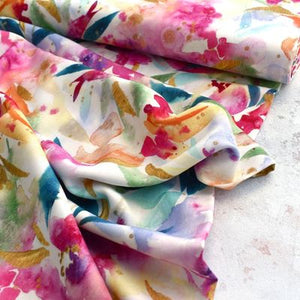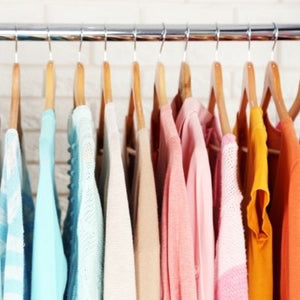We have all come upon a pattern we fall in love with that recommends using a knit fabric. But what type of knit fabric would work best? Are all knits interchangeable? What the heck is the difference? Let us help demystify the most popular types of knit fabrics and give you some tips and tricks for working with them.
- Content
- Common fibers include cotton, rayon (including bamboo, modal, EcoVero, and more), polyester, and wool.
- These are often blended with spandex to allow for more stretch and better recovery.
- What to Know
- Jersey is the most versatile of all knit fabrics. For any knitters out there, it is a classic Stockinette stitch with a knit side (right) and a purl side (wrong).
- It is soft and breathable, easy to care for, and comes in light to mid-weights.
- When cut, jersey knits tend to curl to the right side.
- It should always be sewn with a ballpoint needle and a stretch stitch.
- What to Make
- T-shirts, tank tops, dresses, skirts, tunics, turtlenecks, cardigans, robes, joggers, underwear, bralettes...the list goes on!
- Rayon jersey knits offer more drape and fluidity, and cotton jersey knits are a bit more stable and better suited for those new to sewing with knits.
- Pro Tip—Scraps of jersey fabric can be used to construct a ton of small projects, from underwear to headbands. Keep those ideas in mind when cutting out larger garments and considering layout. You'll find there's a lot more life in your fabric than you may have thought!

- Content
- Common fibers include cotton, rayon (including bamboo, modal, EcoVero, and more), polyester, acrylic, and wool.
- Multiple fiber types are mixed to create different weights and textures.
- Similar to a jersey, these too are often blended with spandex for better recovery.
- What to Know
- As the name indicates, rib knits are characterized by the ribbed surface created but the knit/purl construction. This offers amazing stretch and recovery.
- They are offered in a wide variety of weights and knit densities. You can find lighter, denser rib knits similar to a jersey, looser, chunkier sweater-type rib knits, and lots of styles in between.
- Again, always use a stretch stitch and a ballpoint needle in a size suitable for your fabric's weight.
- What to Make
- Everything from t-shirts and tank tops to turtlenecks and dresses.
- Due to the wide range of weights and textures, rib knits work well for just about any knit garment. It is a popular choice for more form-fitting garments due to the excellent stretch and conforming nature of the rib-style knit.
- It can also be used for hem bands, necklines, and cuffs to finish off other knit garments.
- Pro Tip—Rib knits can be found in various widths and patterns. For example, a 2x2 rib indicates the ribs, or wales, are two stitches wide and evenly spaced. A 4x2 means that one rib is twice as wide as the one next to it. Evenly spaced rib knits do not have a right side or a wrong side and will mostly lay flat.

- Content
- Common fibers include cotton, rayon, wool, polyester, acrylic, and spandex.
- Typically three or four different fibers are blended to get a particular look, feel, warmth, or texture.
- Polyester and acrylic are often used to add thickness and warmth without adding a lot of weight.
- What to Know
- Similar to rib knits, sweater knits are also available in a wide range of weights and densities, from the thin and airy to the thick and chunky.
- Be careful when cutting and sewing not to stretch or distort the fabric.
- Unlike other knits, you may want to serge, or zig-zag stitch seam allowances on loose sweater knits to prevent unraveling.
- Sweater knits should be hand washed or machine washed on gentle and laid flat to dry. They should never be put in the dryer.
- What to Make—Cardigans, sweaters, hoodies, dresses, and hats.
- Pro Tip—Always stabilize areas of stress that tend to stretch out (ex. shoulder seams) with elastic, twill tape, or lightweight interfacing during construction.

- Content
- Typical blends include rayon, polyester, nylon, and/or spandex.
- Nylon is the critical component to watch for as it helps prevent these knits from bagging out with wear (especially at knees and elbows)
- What to Know
- Double knit fabrics are arguably the most stable of all knits!
- They come in various medium to heavy weights and offer a good amount of structure, making them a dream to sew with.
- Plus, they have four-way stretch and are reversible too!
- What to Make—Tops, dresses, skirts, pants, leggings, and jackets.
- Pro Tips—Ponte/double knits are a great choice for sewers new to sewing with knits. They are also fantastic for color-blocking since their stability allows for less distortion and easier sewing!

French Terry/Sweatshirt Fleece
- Content
- These knits are most commonly cotton or a blend of cotton with other natural and man-made fibers, such as hemp, rayon, and polyester.
- Spandex is also a typical addition for better stretch and recovery.
- What to Know
- Which is which? French Terry is recognized by the characteristic loops on the wrong side of the fabric. Sweatshirt fleece is typically the same base fabric (with the loops on one side), but the loops have been cut and brushed, creating the soft fleecy backside and plush thickness.
- Both of these knits are thicker and have limited stretch, making them some of the more stable and easy to sew with.
- Both fabrics wash nicely and sew up easily with a stretch stitch on a sewing machine using a ballpoint needle as well as on a serger .
- What to Make—Sweatshirts, hoodies, joggers, robes, vests, and jackets.
- Pro Tips—Both of these fabrics may pill over time with washing and wearing. Avoiding the dryer helps ward this off, and a razor blade or sweater comb can come in handy to remove any pills that do form without damaging the fabric.

We SEW want to know what you think! What are some of your favorite types of knit fabrics and patterns to sew with?







I,too am swooning over this most helpful discussion on knit fabrics. It’s the most comprehensive for use by beginners.
I’m just getting back into sewing after many years and the fibers and fabrics have changed!
I’ll need a lot of practice on scraps before I begin to sew on garments.
This is so helpful. I am swooning over all of your knits but clueless about uses, issues. I am a craft sewer (on Whidbey Island, we are neighbors!) but have set a goal to begin making apparel for myself and family. I have just found your website and can’t wait to make something with some of your gorgeous fabric!! Julia in Clinton, WA
Leave a comment